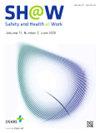Quantitative Assessment of Work-related Hand-arm Vibration Exposure Among Workers in the Construction, Underground Coal Mining, Wood Working, and Metal Working Industry: The German Hand-arm Vibration Study
IF 2.9
3区 医学
Q1 PUBLIC, ENVIRONMENTAL & OCCUPATIONAL HEALTH
引用次数: 0
Abstract
Background
Standardized exposure assessments were conducted to quantify the historical occupational exposure to hand-arm vibration of workers in the German construction, underground coal mining, woodworking, and metalworking industries.
Methods
A two-step approach was used to assess historical vibration exposure. In the first step, individual work histories were reconstructed by standardized personal interviews. The interview focused on the identification of relevant power tools used throughout the working life. In the second step, an equipment-exposure-matrix was constructed by industrial hygiene measurements. By linking the power tools in the work history to the equipment-exposure-matrix, individual daily, and long-term vibration exposures can be quantified.
Results and conclusions
A total of 423 power tools were identified for 5,115 exposure segments over a period of 50 years. 97.2% of the vibration values were based on industrial hygiene measurements. The total vibration value (ahv) of the power tools used varied between 0.8 m/s2 and 65.2 m/s2 with a median value of 14.2 m/s2. The median value of cumulative vibration exposure is Dhv = 121,971 (range: 23-3,374,640) m2/s4·day, corresponding to a daily vibration exposure of ahv(8) = 7 m/s2 for 2489 working days (11.3 years).
This study provides a detailed description of hand-arm vibration exposure among workers in the related industries studied. Our analyses indicate that the quantification of daily vibration exposure is often uncertain and should be interpreted with caution. In contrast, cumulative vibration exposure is a more reliable exposure parameter for describing general working conditions and for guiding the prevention and compensation of vibration-related health problems.
建筑、地下煤矿、木工和金属加工行业工人与工作相关的手臂振动暴露的定量评估:德国手臂振动研究
背景:进行标准化暴露评估,以量化德国建筑、地下煤矿、木工和金属加工行业工人对手臂振动的历史职业暴露。方法采用两步法评估历史振动暴露。第一步,通过标准化的个人访谈重构个人的工作经历。访谈的重点是识别在整个工作寿命中使用的相关电动工具。第二步,通过工业卫生测量构建设备暴露矩阵。通过将工作历史中的电动工具与设备暴露矩阵联系起来,可以量化个人每日和长期的振动暴露。结果和结论在50年的时间里,共鉴定出5115个接触段的423种电动工具。97.2%的振动值基于工业卫生测量。使用的电动工具的总振动值(ahv)在0.8 m/s2 ~ 65.2 m/s2之间变化,中位数为14.2 m/s2。累积振动暴露中位数为Dhv = 121,971(范围:23-3,374,640)m2/s4·day,对应于2489个工作日(11.3年)的每日振动暴露ahv(8) = 7 m/s2。本研究详细描述了相关行业工人的手臂振动暴露情况。我们的分析表明,每日振动暴露的量化往往是不确定的,应谨慎解释。相比之下,累积振动暴露是描述一般工作条件和指导与振动有关的健康问题的预防和补偿的更可靠的暴露参数。
本文章由计算机程序翻译,如有差异,请以英文原文为准。
求助全文
约1分钟内获得全文
求助全文
来源期刊

Safety and Health at Work
Social Sciences-Safety Research
CiteScore
6.40
自引率
5.70%
发文量
1080
审稿时长
38 days
期刊介绍:
Safety and Health at Work (SH@W) is an international, peer-reviewed, interdisciplinary journal published quarterly in English beginning in 2010. The journal is aimed at providing grounds for the exchange of ideas and data developed through research experience in the broad field of occupational health and safety. Articles may deal with scientific research to improve workers'' health and safety by eliminating occupational accidents and diseases, pursuing a better working life, and creating a safe and comfortable working environment. The journal focuses primarily on original articles across the whole scope of occupational health and safety, but also welcomes up-to-date review papers and short communications and commentaries on urgent issues and case studies on unique epidemiological survey, methods of accident investigation, and analysis. High priority will be given to articles on occupational epidemiology, medicine, hygiene, toxicology, nursing and health services, work safety, ergonomics, work organization, engineering of safety (mechanical, electrical, chemical, and construction), safety management and policy, and studies related to economic evaluation and its social policy and organizational aspects. Its abbreviated title is Saf Health Work.
 求助内容:
求助内容: 应助结果提醒方式:
应助结果提醒方式:


